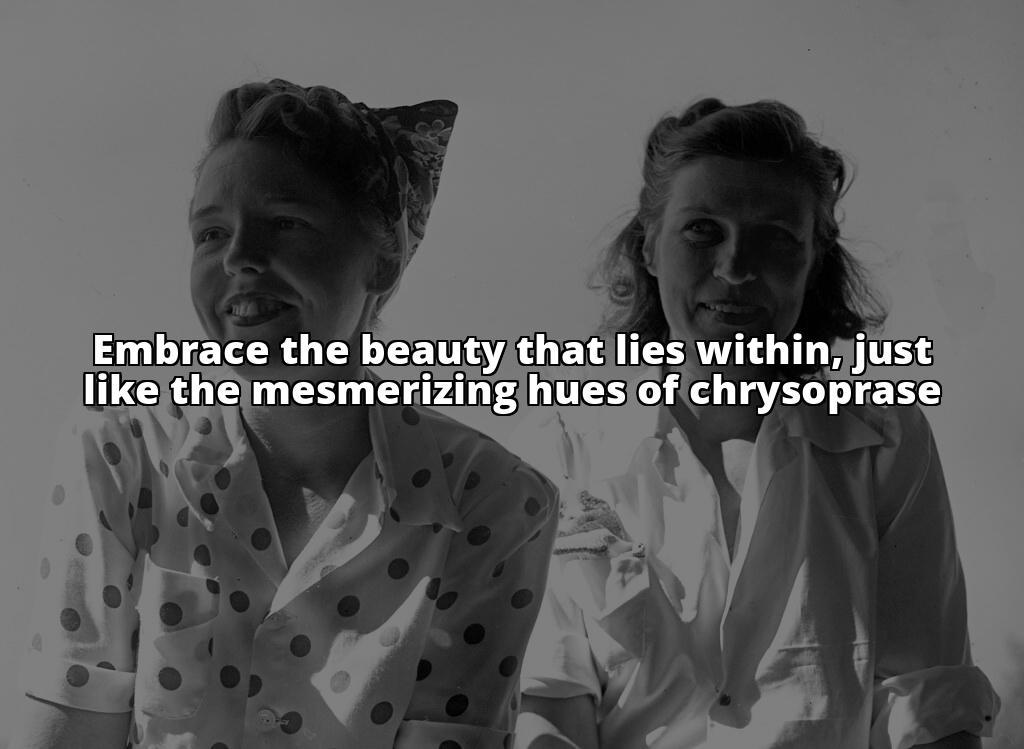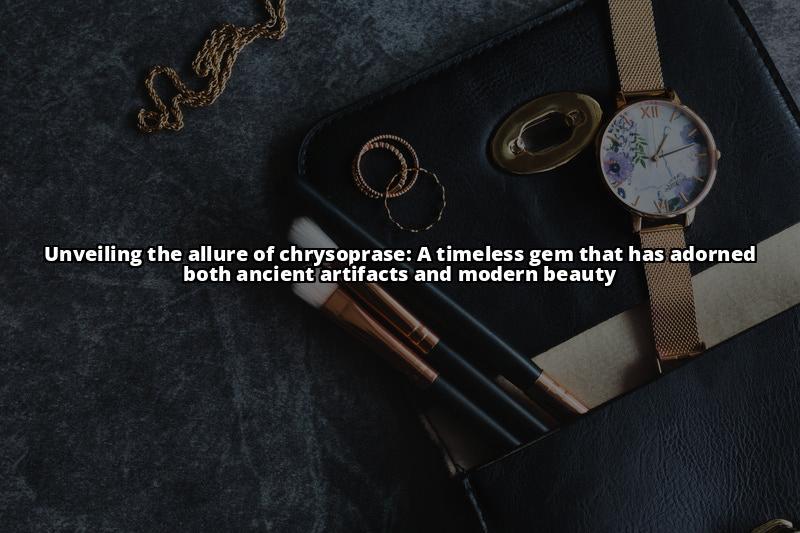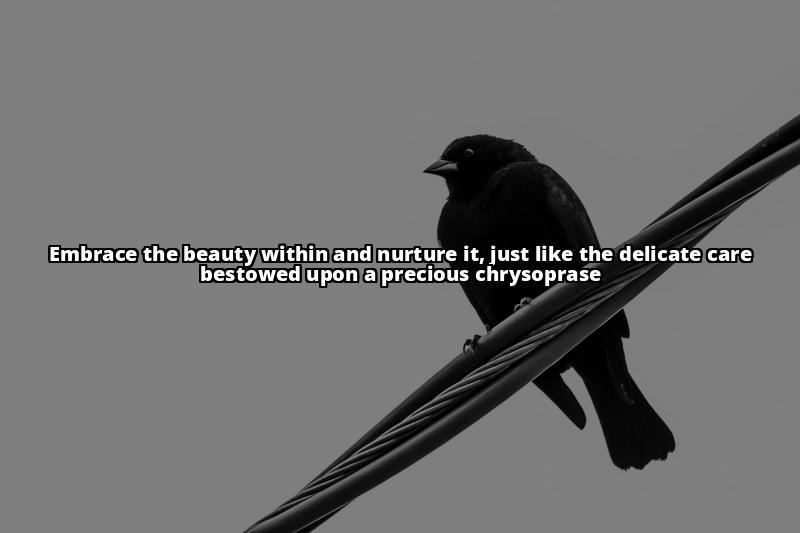What you will learn about chrysoprase by reading this article:
- The origins and formation of chrysoprase, including the different locations where it is found and the geological processes involved.
- The historical significance and cultural uses of chrysoprase, including its use by ancient civilizations and the symbolism associated with it.
- The physical and optical properties of chrysoprase, such as its color range, transparency, and play of light.
- The value and uses of chrysoprase, including its rarity as a gemstone and its applications in jewelry making.
- How to care for chrysoprase jewelry, including cleaning methods and precautions to avoid damage.
- How to identify genuine chrysoprase and distinguish it from imitations.
- The color and chemical composition of chrysoprase and the factors that influence its color.
- The impact of inclusions on the color of chrysoprase.
- The key takeaways of the article and an encouragement to explore and appreciate the beauty of chrysoprase.

What is Chrysoprase and How is it Formed?
Chrysoprase, also known as chrysophrase or chrysoprasus, is a captivating variety of chalcedony. It is formed through intricate geological processes involving silica and specific minerals. Small amounts of nickel compounds infiltrate the silica matrix, giving the gemstone its distinctive green color. Over time, as silica crystallizes, the nickel compounds become embedded within the chalcedony, creating the mesmerizing beauty of chrysoprase.

Historical Significance and Cultural Uses
Chrysoprase has a rich historical significance and has been treasured by civilizations throughout history. The gemstone was highly prized by the Greeks, Romans, and Egyptians, who used it to create seals, signets, jewelry, and other ornamental objects. Its vivid green color captivated these ancient cultures, and they recognized its aesthetic appeal and symbolic value.
In Greek and Roman societies, chrysoprase was associated with fertility and abundance, believed to bring good fortune and prosperity. The Egyptians considered chrysoprase a stone of protection and healing, with the power to bring clarity of thought and mend a broken heart.

Physical and Optical Properties
Chrysoprase possesses a range of physical and optical properties that make it truly remarkable. The gemstone is translucent and comes in shades ranging from yellowish green to green. Its translucency allows light to penetrate the stone, resulting in a captivating play of light and a vibrant glow.
The color of chrysoprase is influenced by the presence of nickel compounds and specific oxides. A study published by Nature.com explores the intricate relationship between color, elements such as nickel, chromium, and iron, and the gemstone’s hue and chroma.
| Physical and Optical Properties | Value and Uses |
|---|---|
| Translucency | Rarity and beauty |
| Shades ranging from yellowish green to green | Popular choice for jewelry making |
| Play of light and vibrant glow | Practical and industrial applications |
| Influenced by presence of nickel compounds and specific oxides | Durability and resistance to scratches |
| Study explores relationship between color and elements | Alluring green hue adds elegance and sophistication |

Value and Uses
Chrysoprase is highly valued for its rarity and beauty, making it a sought-after gemstone. Its vibrant green color and unique characteristics make it a popular choice for jewelry making. Chrysoprase is commonly used for creating beads, cabochons, and faceted stones that showcase its natural beauty.
Beyond jewelry, chrysoprase has practical and industrial applications. Its durability and resistance to scratches make it suitable for decorative objects and carvings. The gemstone’s alluring green hue adds elegance and sophistication to any design.

Care and Maintenance
To ensure the longevity and beauty of chrysoprase jewelry, proper care and maintenance are essential. Follow these tips to keep your chrysoprase pieces looking their best:
- Clean with Warm Soapy Water: Gently wash your chrysoprase jewelry using warm soapy water and a soft brush. Avoid harsh chemicals or abrasive cleaners that can damage the stone.
- Avoid Prolonged Sunlight: Chrysoprase is sensitive to prolonged exposure to sunlight, which can fade its color over time. Store your jewelry in a cool, dark place when not wearing it to preserve its vibrant green hue.
- Secure Fastening: Ensure that chrysoprase gemstones are securely fastened in jewelry designs to prevent loss or damage. Regularly check the settings and clasps for signs of wear or weakness.
For more detailed information on caring for gemstones, including chrysoprase, refer to the resources provided by Fire Mountain Gems. Their expertise in gemstone care will help you maintain the beauty and integrity of your chrysoprase jewelry.
Identification and Imitations
Identifying genuine chrysoprase can be challenging due to imitations and misnomers in the market. One common imitation is dyed green chalcedony, which attempts to replicate the vibrant green color of chrysoprase. However, there are key characteristics that can help distinguish authentic chrysoprase from imitations:
- Color Consistency: Genuine chrysoprase displays a consistent and even distribution of vibrant green color. Dyed chalcedony may have uneven coloration or an artificial appearance.
- Transparency: Chrysoprase is translucent, allowing light to pass through it. Dyed chalcedony may appear opaque or lack the same level of transparency.
If you are unsure about the authenticity of a chrysoprase gemstone, consult experts or gemological laboratories for accurate identification. These professionals have the expertise and tools to assess the gemstone’s authenticity and provide reliable information.
Color and Chemical Composition
A study conducted by Nature.com explored the color and chemical composition of chrysoprase gemstones. It revealed that the gemstone’s color is influenced by specific colorimetric coordinates, oxides, and transition-metal elements.
The study established a comprehensive color grading system for chrysoprase, providing insights into the factors that determine its hue and chroma. Nickel, chromium, and iron were found to have a significant impact on the gemstone’s color, creating its mesmerizing green allure.
The study also revealed the presence of nickel-rich pimelite inclusions, which contribute to the color of chrysoprase. The crystallinity of the gemstone and the presence of moganite and layer silicates were identified as additional factors influencing its color.
Inclusions and Color
Inclusions significantly affect the color and appearance of chrysoprase. Nickel-rich pimelite inclusions, mentioned in the study by Nature.com, add depth and character to the gemstone, enhancing its visual appeal.
The crystallinity of chrysoprase and the presence of moganite and layer silicates also impact its color. These factors interact with nickel compounds and oxides, influencing the gemstone’s overall appearance and creating its signature green hue.
Conclusion
Chrysoprase is a gemstone shrouded in mystery and beauty. Its vibrant green color, historical significance, and unique properties make it a treasure to behold. From its fascinating geological formation to its use in ancient cultures, chrysoprase has captivated humanity for centuries.
The valuable insights provided by the study conducted by Nature.com shed light on the intricate relationship between color and chemical composition in chrysoprase gemstones. This research deepens our understanding of the factors that contribute to the gemstone’s mesmerizing allure.
As you explore the world of gemstones, take a moment to appreciate the splendor of chrysoprase. Whether adorning jewelry or adding beauty to the world around us, this remarkable gemstone continues to captivate hearts with its enchanting green hue.
Personal Story: Discovering the Healing Power of Chrysoprase
As a gemstone enthusiast, I have always been intrigued by the vibrant green color of chrysoprase. However, it wasn’t until I stumbled upon a personal experience that I truly understood its healing power.
A few years ago, my friend Sarah was going through a difficult time. She had been dealing with chronic stress and anxiety, and it was taking a toll on her overall well-being. Wanting to support her, I decided to gift her a chrysoprase necklace.
Sarah wore the necklace every day, and soon enough, she started noticing a difference in her mood and energy levels. The soothing green hue of the chrysoprase seemed to have a calming effect on her, helping to alleviate her anxiety and promote a sense of tranquility. She found herself feeling more grounded and centered, able to face challenges with a newfound strength.
Intrigued by Sarah’s experience, I delved deeper into the healing properties of chrysoprase. I discovered that this gemstone is believed to promote emotional balance, encourage compassion, and attract abundance and prosperity. Its connection to the heart chakra further enhances its ability to heal emotional wounds and foster a sense of love and positivity.
Sarah’s experience with chrysoprase is just one example of the profound impact gemstones can have on our well-being. Whether it’s through their vibrant colors, unique properties, or historical significance, gemstones like chrysoprase have the power to enhance our lives in ways we never imagined.
So, the next time you come across a chrysoprase gemstone, take a moment to appreciate its beauty and consider the possibility of unlocking its healing potential. You might just uncover a whole new world of wellness and serenity.
Questions
What is chrysoprase?
Chrysoprase is a gemstone variety of chalcedony known for its vibrant green color.
Who can wear chrysoprase jewelry?
Anyone can wear chrysoprase jewelry, regardless of their gender or age.
How can chrysoprase benefit me?
Chrysoprase is believed to promote love, compassion, and healing.
What is the best way to clean chrysoprase?
To clean chrysoprase, gently wipe it with a soft cloth and mild soap.
How can I distinguish chrysoprase from other green gemstones?
Chrysoprase has a distinct apple-green color, which sets it apart from other green gemstones.
But isn’t chrysoprase an expensive gemstone?
While chrysoprase can be valuable, there are affordable options available for jewelry enthusiasts.






